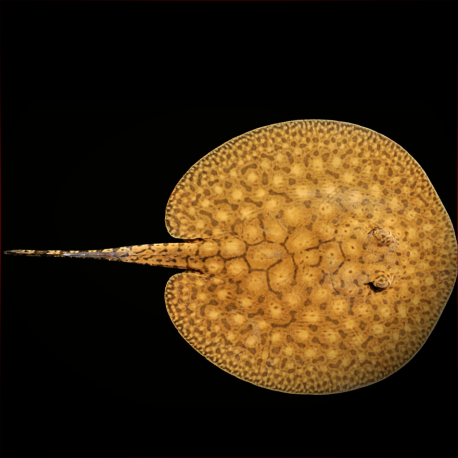More info
Datasheet
| Minimum Tank Size | 650 litres / 171.71 US gallons |
| Maximum Size | 38.1cm / 15.00inches |
| Temperature | 24°C / 75.20°F - 26°C / 78.80°F |
| Hardness | 0-10ºdH |
| pH | 6.5-7.5 |
General Description
Potamotrygon Orbignyi, commonly known as Smooth-Back Stingray or P11, belongs to the family Potamotrygonidae and is native to northern South America, including regions in Venezuela, Guyana, Suriname, French Guiana, Brazil, and Bolivia. These freshwater stingrays are part of a group that have evolved to inhabit solely freshwater environments.
Aquarium Setup
Maintaining Potamotrygon Orbignyi in a tank requires careful consideration due to their unique needs. Tank decorations are optional, but large pieces of bogwood, beech branches, or rocks can be added. Substrate choice ranges from river sand to gravel, with sand mimicking natural habitat aspects. An efficient biological filter is crucial due to their waste production, with sump systems or external canister filters popular choices for water cleanliness. A secure lid is essential to prevent any potential escapes.
Behaviour
Potamotrygon Orbignyi, being top predators, require a peaceful tank environment as they do not thrive well with aggressive tankmates due to their preference for a quiet life. They may show territorial behavior and should ideally be housed with species large enough not to be eaten, such as certain cichlids, characins, or cyprinids. Social compatibility is essential, and caution is advised with other fish species to prevent injuries or hybridization risks.
Feeding and Diet
Wild Potamotrygon Orbignyi primarily feed on fish and aquatic invertebrates and require at least two feedings per day. They are high-metabolism fish that prefer an exclusively meaty diet, with options like bloodworms, mussels, prawns, and earthworms. Avoid feeding them mammal meats or live feeder fish, as these can negatively impact their health. New arrivals may initially be reluctant to eat and require live foods to transition to a varied diet for optimal health.
Reproduction & Dimorphism
Potamotrygon Orbignyi exhibit matrotrophic viviparity, where young develop inside the mother and are born live and fully-formed. The breeding process can be challenging, requiring patience in providing suitable tank conditions and compatible mating partners. Sexual dimorphism is easily distinguishable, with males possessing claspers used for insemination. Successful captive breeding has been observed, with gestation periods that can be influenced by diet and care.
Habitat and Distribution
Inhabitants of various freshwater biotopes, Potamotrygon Orbignyi are commonly found in sand banks, major river shallows, tributaries with mud or sand substrates, and flooded forest areas during wet seasons. Their distribution spans water bodies in the Amazon drainage, Rio Orinoco, Rio Paraná, and smaller rivers across the northern regions of South America.

